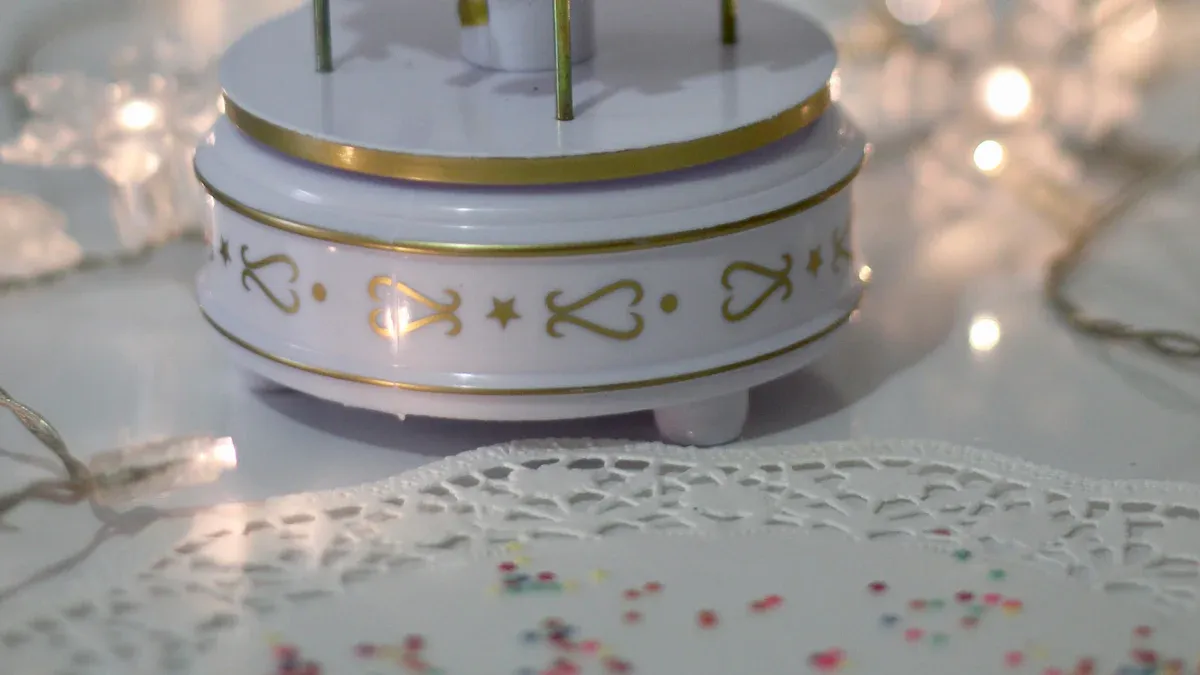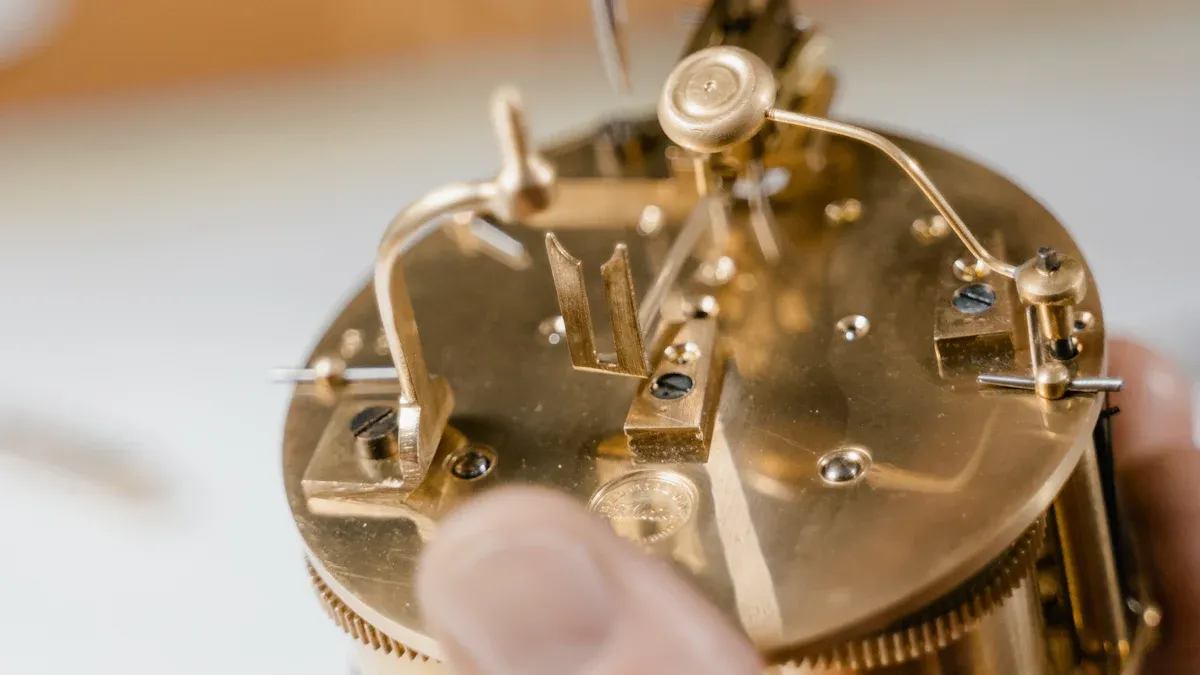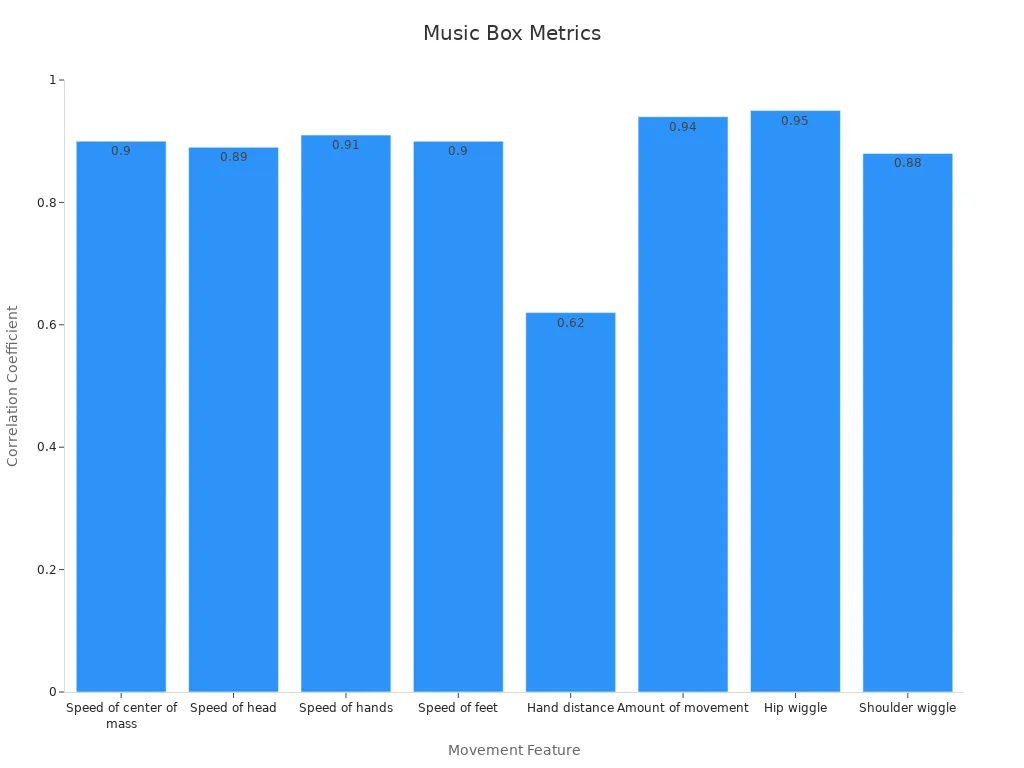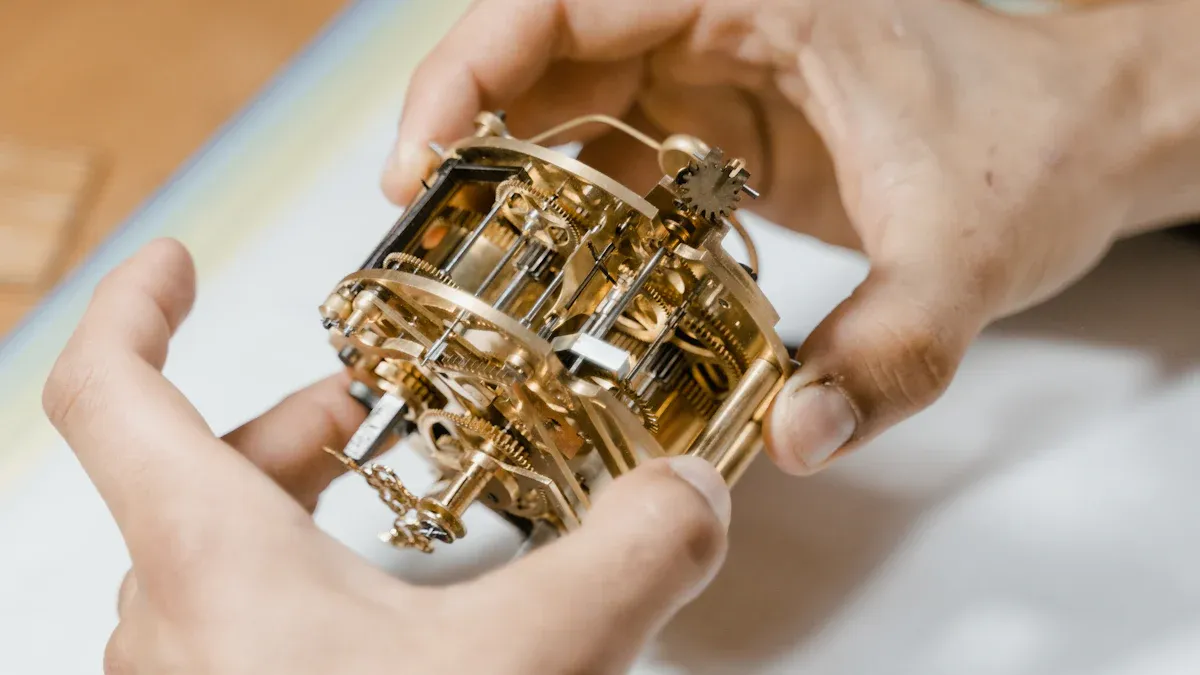
A music box movement is a mechanical assembly that transforms motion into enchanting melodies. This intricate system powers various devices, from a Wooden Metal Music Box to a Hand Driven Music Box. By plucking tuned teeth on a comb, the music box mechanism produces harmonious notes, captivating listeners with its timeless charm. Dancing Music Box designs often incorporate these movements to pair music with graceful motion.
Key Takeaways
- A music box movement is a machine that makes motion into lovely tunes, delighting people with its beauty.
- Accuracy is very important in music box making; even tiny changes can change the tune, keeping the sound great.
- Music box parts, like cylinder and disc styles, have unique features, making both detailed songs and personal tunes possible.
Understanding the music box movement
What is a music box movement?
A music box movement is the mechanical heart of a music box, responsible for producing its signature melodies. This intricate assembly consists of various components working together to transform mechanical energy into sound. Over the years, advancements in design and manufacturing have refined the movement’s precision and reliability. For instance, Ningbo Yunsheng Musical Movement Manufacturing Co., Ltd. developed the first musical movement with independent intellectual property rights in China in 1992. Today, the company holds over 50% of the global market share, showcasing its leadership in the industry.
| Year | Description |
|---|---|
| 1992 | The first musical movement with independent intellectual property rights in China was developed by Ningbo Yunsheng Company. |
| Achievements | Yunsheng has made significant advancements over several decades, becoming a global leader in musical movement manufacturing. |
| Market Share | Yunsheng holds over 50% of the global market share for musical movements. |
How does a music box movement work?
The operation of a music box movement involves a series of precise mechanical steps. Each step contributes to the creation of the enchanting melodies that music boxes are known for. The process unfolds as follows:
- A key is turned clockwise to wind the mechanism, compressing a spring.
- The spring releases stored energy, which powers a shaft connected to the cylinder.
- The rotating cylinder, equipped with strategically placed spikes, interacts with the comb’s tines to produce sound.
- The music continues to play as long as the box remains open and the spring retains energy.
- Closing the box activates a stopper mechanism, halting the cylinder’s rotation and silencing the music.
- The speed of the melody depends on the amount of wind-up, with faster tempos occurring when fully wound and slower tempos as the energy diminishes.
This step-by-step process highlights the ingenuity behind the music box movement, where mechanical energy is meticulously converted into harmonious sound.
Mechanical precision in melody creation
The creation of melodies in a music box movement relies on exceptional mechanical precision. Each component, from the cylinder to the comb, must be crafted with accuracy to ensure the correct notes are played. The cylinder’s spikes are carefully positioned to pluck specific tines on the comb, producing distinct pitches. Even slight deviations in the placement of these spikes can alter the melody, underscoring the importance of precision engineering.
Manufacturers like Ningbo Yunsheng Musical Movement Manufacturing Co., Ltd. have mastered this art through decades of innovation. Their expertise ensures that every music box movement delivers consistent and high-quality sound. This level of craftsmanship not only preserves the charm of traditional music boxes but also enhances their appeal in modern applications.
Components of a music box movement

The comb: Vibrating to produce sound
The comb serves as the primary sound-producing component in a music box movement. This metallic piece consists of a series of tines, each tuned to a specific pitch. When a tine vibrates, it generates a musical note. The length and thickness of each tine determine the pitch, with longer tines producing lower notes and shorter ones creating higher tones.
The precision of the comb’s design directly impacts the quality of the melody. Manufacturers like Ningbo Yunsheng Musical Movement Manufacturing Co., Ltd. ensure that each tine is meticulously crafted to deliver consistent and harmonious sound. This attention to detail preserves the timeless charm of music boxes while meeting modern performance standards.
The cylinder: Rotating to pluck the comb’s teeth
The cylinder plays a pivotal role in the operation of a music box movement. This rotating component is embedded with strategically placed pins that interact with the comb’s tines. As the cylinder turns, each pin plucks a specific tine, causing it to vibrate and produce a note. The arrangement of the pins determines the sequence of notes, creating the melody.
The mechanical process involves several key steps:
- The crankshaft rotates the pinned cylinder through the barrel wheel.
- Each pin interacts with the comb’s teeth, plucking them to produce sound.
- Longer teeth generate lower notes, while shorter teeth produce higher ones.
This intricate mechanism highlights the cylinder’s importance in translating mechanical motion into music. The following chart illustrates the correlation between various movement features and their impact on performance:

The disc: An alternative mechanism for melodies
In some music boxes, a disc replaces the cylinder as the melody-generating component. The disc features perforations or raised bumps that interact with the comb’s tines. As the disc rotates, these bumps pluck the tines, producing sound. This design offers greater flexibility in melody selection, as users can swap discs to play different tunes.
Disc-based mechanisms gained popularity in the late 19th century due to their versatility. Unlike cylinders, which are fixed to a single melody, discs allow for a broader repertoire. This innovation expanded the appeal of music boxes, making them a cherished item for collectors and music enthusiasts alike.
The winding mechanism: Powering the movement
The winding mechanism provides the energy needed to operate a music box movement. By turning a key or crank, users compress a spring inside the movement. As the spring unwinds, it releases stored energy, driving the rotation of the cylinder or disc. This process ensures a steady and consistent playback of the melody.
The efficiency of the winding mechanism directly affects the duration and quality of the music. High-quality mechanisms, like those produced by Ningbo Yunsheng Musical Movement Manufacturing Co., Ltd., are designed to maximize energy storage and minimize wear over time. This ensures that the music box delivers reliable performance for years to come.
Types of music box mechanisms

Cylinder music boxes: Features and operation
Cylinder music boxes represent the classic design of music box mechanisms. These devices use a rotating cylinder embedded with precisely placed pins to pluck the tines of a comb, creating melodies. The cylinder’s design allows for intricate and longer compositions, making it ideal for complex musical arrangements.
Key performance metrics highlight the precision of cylinder music boxes:
- Reeds Dimensions: The length and width of each reed are tailored to produce specific tones, ensuring high-quality sound.
- Vibrating Plate Material: Materials like metal or wood influence the tone’s richness and volume.
- Resonant Characteristics: The cylinder’s construction enhances resonance, delivering a fuller sound.
Manufacturers often incorporate advanced control systems, such as microprocessors, to refine melody playback. This combination of craftsmanship and technology ensures cylinder music boxes remain a timeless choice for music enthusiasts.
Disc music boxes: Features and operation
Disc music boxes offer a more versatile alternative to cylinder designs. Instead of a fixed cylinder, these mechanisms use interchangeable discs with perforations or raised bumps. As the disc rotates, these features pluck the comb’s tines to produce sound. This design allows users to swap discs, enabling a broader selection of melodies.
The evolution of disc music boxes reflects advancements in technology. For example:
| Year | Development/Feature | Description |
|---|---|---|
| 1979 | Collaboration Announcement | Philips and Sony partnered to develop compact disc technology. |
| 1984 | First CD Player Release | Sony launched the first commercial CD player. |
| 1995 | CDs Dominate Market | CDs became the primary medium for music storage. |
This adaptability has made disc music boxes a popular choice for collectors and those seeking customizable musical experiences.
Key differences between cylinder and disc music boxes
The operational differences between cylinder and disc music boxes can be summarized as follows:
| Feature | Cylinder Music Boxes | Disc Music Boxes |
|---|---|---|
| Mechanism | Uses a perforated paper cylinder | Uses a disc with perforations or bumps |
| Melody Complexity | Plays longer, more complex melodies | Offers flexibility with interchangeable discs |
| Precision | Highly precise due to fixed design | Slightly less precise but more versatile |
| Operation | Requires winding a key to rotate the cylinder | Requires winding a key to rotate the disc |
These distinctions highlight the unique strengths of each mechanism, catering to different preferences and applications.
Applications and popularity of music box mechanisms
Music box mechanisms find applications in various settings, from decorative items to personalized gifts. The market for these mechanisms continues to grow, with a projected value of US$ 37.16 million by 2033, driven by a CAGR of 5.89%. Key trends include:
- Increased consumer spending in North America due to high disposable income.
- Rising demand for customization and personalization in music boxes.
The emotional connection associated with music boxes also plays a significant role. Consumers often view them as heartfelt gifts or cherished keepsakes, ensuring their enduring popularity across generations.
Music box movements transform mechanical energy into enchanting melodies through precise engineering. Their intricate craftsmanship reflects timeless artistry, captivating audiences with both sound and design. Cylinder mechanisms excel in complexity, while disc mechanisms offer versatility. Together, they showcase the enduring charm of music boxes, blending tradition with innovation to create unforgettable musical experiences.
Post time: May-24-2025
- English
- French
- German
- Portuguese
- Spanish
- Russian
- Japanese
- Korean
- Arabic
- Irish
- Greek
- Turkish
- Italian
- Danish
- Romanian
- Indonesian
- Czech
- Afrikaans
- Swedish
- Polish
- Basque
- Catalan
- Esperanto
- Hindi
- Lao
- Albanian
- Amharic
- Armenian
- Azerbaijani
- Belarusian
- Bengali
- Bosnian
- Bulgarian
- Cebuano
- Chichewa
- Corsican
- Croatian
- Dutch
- Estonian
- Filipino
- Finnish
- Frisian
- Galician
- Georgian
- Gujarati
- Haitian
- Hausa
- Hawaiian
- Hebrew
- Hmong
- Hungarian
- Icelandic
- Igbo
- Javanese
- Kannada
- Kazakh
- Khmer
- Kurdish
- Kyrgyz
- Latin
- Latvian
- Lithuanian
- Luxembou..
- Macedonian
- Malagasy
- Malay
- Malayalam
- Maltese
- Maori
- Marathi
- Mongolian
- Burmese
- Nepali
- Norwegian
- Pashto
- Persian
- Punjabi
- Serbian
- Sesotho
- Sinhala
- Slovak
- Slovenian
- Somali
- Samoan
- Scots Gaelic
- Shona
- Sindhi
- Sundanese
- Swahili
- Tajik
- Tamil
- Telugu
- Thai
- Ukrainian
- Urdu
- Uzbek
- Vietnamese
- Welsh
- Xhosa
- Yiddish
- Yoruba
- Zulu
- Kinyarwanda
- Tatar
- Oriya
- Turkmen
- Uyghur
